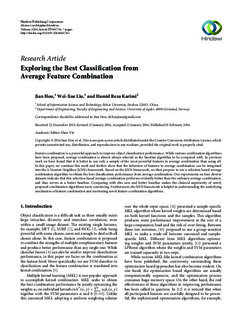| dc.contributor.author | Hou, Jian | |
| dc.contributor.author | Liu, Wei-Xue | |
| dc.contributor.author | Karimi, Hamid Reza | |
| dc.date.accessioned | 2014-12-12T09:42:00Z | |
| dc.date.available | 2014-12-12T09:42:00Z | |
| dc.date.issued | 2014 | |
| dc.identifier.citation | Hou, J., Liu, W.-X., & Karimi, H. R. (2014). Exploring the best classification from average feature combination. Abstract and Applied Analysis, 2014, 1-7. doi: 10.1155/2014/602763 | nb_NO |
| dc.identifier.issn | 1085-3375 | |
| dc.identifier.uri | http://hdl.handle.net/11250/227081 | |
| dc.description | Published version of an article in the journal: Abstract and Applied Analysis. Also available from the publisher at: http://dx.doi.org/10.1155/2014/602763 Open Access | nb_NO |
| dc.description.abstract | Feature combination is a powerful approach to improve object classification performance. While various combination algorithms have been proposed, average combination is almost always selected as the baseline algorithm to be compared with. In previous work we have found that it is better to use only a sample of the most powerful features in average combination than using all. In this paper, we continue this work and further show that the behaviors of features in average combination can be integrated into the k-Nearest-Neighbor (kNN) framework. Based on the kNN framework, we then propose to use a selection based average combination algorithm to obtain the best classification performance from average combination. Our experiments on four diverse datasets indicate that this selection based average combination performs evidently better than the ordinary average combination, and thus serves as a better baseline. Comparing with this new and better baseline makes the claimed superiority of newly proposed combination algorithms more convincing. Furthermore, the kNN framework is helpful in understanding the underlying mechanism of feature combination and motivating novel feature combination algorithms. | nb_NO |
| dc.language.iso | eng | nb_NO |
| dc.publisher | Hindawi Publishing Corporation | nb_NO |
| dc.title | Exploring the best classification from average feature combination | nb_NO |
| dc.type | Peer reviewed | nb_NO |
| dc.type | Journal article | |
| dc.subject.nsi | VDP::Mathematics and natural science: 400::Mathematics: 410::Applied mathematics: 413 | nb_NO |
| dc.source.pagenumber | 1-7 | nb_NO |
| dc.source.journal | Abstract and Applied Analysis | nb_NO |
| dc.identifier.doi | 10.1155/2014/602763 | |
